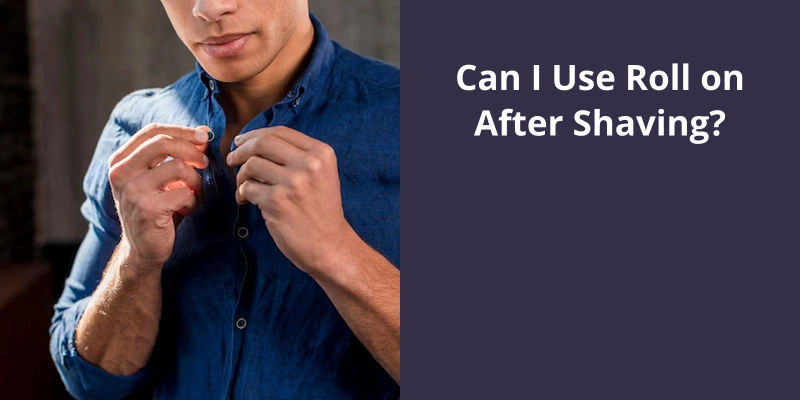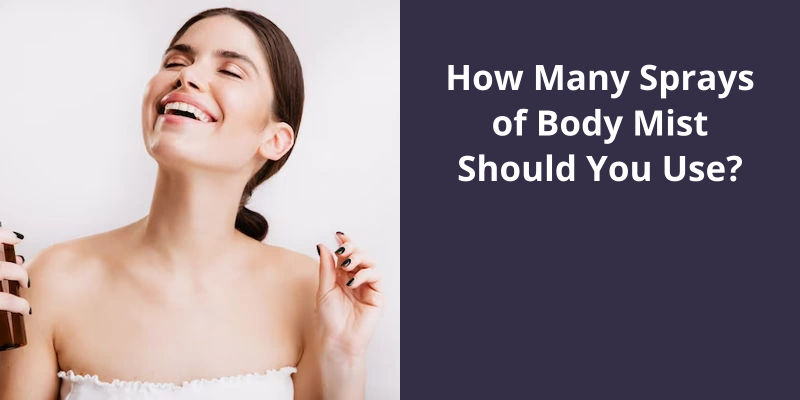Yes, you can use a roll-on after shaving, but it’s important to consider a few things. First, ensure the roll-on deodorant is alcohol-free because alcohol can cause stinging and irritation on the freshly shaved skin. Second, it’s recommended to wait for a few minutes after shaving to allow your skin to calm down before applying the deodorant. Regular use of an alcohol-free roll-on deodorant after shaving can help soften your skin over time and minimize any potential irritation. Also, using a deodorant post-shaving can give you a fresh feeling and keeps you smelling great the whole day.

What Skincare to Avoid After Shaving?
Shaving is a common beauty ritual that everyone experiences at some point in their lives. However, it can also be a painful and irritating process if proper skincare practices aren’t followed. One of the most important things to keep in mind after shaving is to avoid using any skincare products that could further irritate the skin. This includes soap, which can strip the skin of it’s natural oils, leaving it dry and prone to irritation.
This is because makeup can clog the pores and prevent the skin from breathing. This can lead to breakouts and other skin problems, especially if you’ve sensitive skin. Therefore, it’s best to avoid wearing makeup for at least a few hours after shaving.
If you do experience any irritation or discomfort after shaving, it’s always a good idea to use a toner on your face. Toners are specifically designed to help soothe and calm irritated skin. They can help to reduce redness and inflammation, and can also help to restore the natural balance of your skin.
When choosing a toner, it’s important to choose one that’s gentle and non-irritating. Look for products that contain soothing ingredients like aloe vera, chamomile, and cucumber. These ingredients are known for their calming and soothing properties, and can help to reduce inflammation and irritation.
This includes products like exfoliants, which can be too harsh for freshly-shaved skin. Instead, opt for gentle, hydrating skincare products that can help to keep your skin moisturized and healthy.
Tips for Preventing Razor Burn and Ingrown Hairs
- Exfoliate before shaving to remove dead skin cells and dirt that can clog pores and cause ingrown hairs.
- Use a sharp, clean razor to avoid irritation and infection.
- Shave in the direction of hair growth to prevent hair from being pulled or cut too short, both of which can contribute to ingrown hairs.
- Apply a moisturizing shaving cream or gel to help the razor glide smoothly and reduce friction.
- Rinse the razor frequently to remove hair and shaving cream buildup.
- After shaving, apply a soothing lotion or balm to calm inflammation and prevent ingrown hairs.
- Avoid tight clothing that can rub against the skin and cause irritation.
- Consider using an electric razor or depilatory cream instead of traditional shaving.
- If ingrown hairs are a recurring problem, consider consulting a dermatologist for additional treatment options.
Watch this video on YouTube:
Proper shaving is essential for maintaining healthy skin, but it’s not the only step. After you’re done, your skin needs some care to prevent irritation and keep it soft and smooth. Luckily, there are plenty of products available that can help you achieve that, including lotions, oils, and more. Whether you’re a man or a woman, there’s something out there for you, and it’s worth taking the time to find the right one.
What Products Should I Use After Shaving?
In addition to a moisturizer, you may want to consider using a post-shave balm or gel. These products are designed specifically to soothe and calm irritated skin after shaving. Look for products that contain ingredients like aloe vera, chamomile, and lavender, which have natural anti-inflammatory properties.
Another important product to consider is a good quality shaving cream or gel. These products can help to lubricate the skin and prevent razor burn, which can be especially important if you’ve sensitive skin. Look for products that are alcohol-free, as this can dry out the skin and make it more prone to irritation.
If you suffer from razor bumps or ingrown hairs, you may want to try using an exfoliating scrub or serum. These products can help to remove dead skin cells and prevent hair from becoming trapped under the skin. Look for products that contain ingredients like salicylic acid or glycolic acid, which can help to unclog pores and reduce inflammation.
Finally, make sure to always use a sharp razor and avoid shaving over the same area more than once. This can cause unnecessary irritation and increase the risk of nicks and cuts. If you’ve any existing cuts or wounds, be sure to apply a topical antibiotic ointment to prevent infection.
In summary, the key to a successful shaving routine is proper preparation and aftercare. By using the right products and techniques, you can help to prevent irritation, keep your skin looking and feeling healthy, and enjoy a smooth, close shave every time. So next time you shave, make sure to stock up on these essential products and enjoy the benefits of a well-maintained grooming routine.
Proper aftercare is essential in preventing armpit irritation and discomfort after shaving. In the previous section, we discussed the importance of moisturizing your skin after shaving to keep it healthy and well-nourished. However, taking care of your razor is equally important in preventing infections and cuts. Therefore, in this section, we’ll cover some tips to help you maintain your razor and avoid potential complications.
How Do I Stop My Armpits From Hurting After Shaving?
Another tip is to use a sharp razor blade. Dull blades can cause more irritation and pull on your hair, which can cause pain and soreness in your armpits. It’s also important to shave in the direction of hair growth instead of against it. Shaving against the grain can cause ingrown hairs and further irritation, which can cause your armpits to hurt even more.
Exfoliating your underarms before shaving can also help prevent soreness. Use a gentle exfoliating scrub or a loofah to remove dead skin cells, which can clog your razor and cause irritation. Just be careful not to over-exfoliate, as this can also cause redness and soreness.
If you’ve already shaved and your armpits are sore, there are a few things you can do to help soothe the discomfort. Applying a cold compress or ice pack can help reduce inflammation and numb the soreness. You can also try using a topical pain reliever like lidocaine or ibuprofen gel to help numb the area and alleviate the pain.
If your armpits continue to hurt after shaving, it may be a sign of an infection or other underlying condition. If you notice any signs of infection, such as redness, swelling, or pus, be sure to consult your doctor right away. They can provide you with proper treatment and help you prevent future outbreaks.
Tips for Choosing a Shaving Cream or Gel That Is Gentle on Sensitive Skin
- Look for products that are specifically labeled as “gentle” or “for sensitive skin”.
- Avoid products that contain alcohol, fragrance, or other harsh chemicals.
- Choose a product that contains moisturizing ingredients, such as aloe vera or coconut oil.
- Consider using a shaving oil instead of a cream or gel, as it may be less irritating to the skin.
- Test the product on a small area of skin before applying it to your entire face or body.
- If you’ve a history of allergic reactions or skin sensitivities, consult with a dermatologist before trying a new product.
Taking care of our personal hygiene is important, and many of us have a routine in place for shaving and applying deodorant. However, did you know that putting deodorant on immediately after shaving may not be the best idea? In fact, it can lead to some uncomfortable side effects. So, what should you do instead? Read on to find out.
Is It Bad to Put on Deodorant After Shaving?
Shaving is an essential grooming step for most people; it helps keep areas like the underarms, legs, and bikini line smooth and hair-free. However, an often overlooked aspect of shaving is the aftermath, and how to navigate post-shaving skincare. In particular, one often asked question is whether it’s safe to put on deodorant after shaving- putting deodorant right after a shave can be harmful, as it may lead to skin irritation.
It’s best to wait some time after shaving before applying antiperspirant or deodorant. During this time, the skin can repair and regenerate and is less prone to irritation. Ideally, waiting for at least half an hour will suffice. Waiting longer is even better as it allows the skin to cool off and reduces the chances of unwanted reactions from deodorants.
After shaving, it’s also essential to wash the shaved area thoroughly with lukewarm water and mild soap to remove any loose hair, bacteria, and dead skin cells. This will help to prevent skin irritation and infection. Patting the area dry gently is also crucial as rubbing it in a harsh way can cause friction and further irritation.
If you experience skin sensitivity after shaving or have pre-existing skin conditions like eczema or psoriasis, it’s best to avoid using deodorants altogether. Instead, you can try natural alternatives like baking soda, witch hazel, or essential oils. These options are less likely to cause irritation and may even have added benefits like antibacterial and antifungal properties.
Doing so can cause skin irritation, itching, and even lead to infection. In case of skin sensitivity or pre-existing skin conditions, it’s advisable to use natural alternatives to avoid further irritation.
How to Choose the Right Shaving Products to Prevent Irritation
To find the best shaving products and prevent irritation, it’s essential to consider your skin type, hair texture, and personal preferences. Look for products with natural ingredients, soothing agents, and added moisture. Avoid products containing alcohol, fragrances, and harsh chemicals. Opt for a razor with multiple blades and a sharp edge, and change your blades regularly. Test products on a small area before use and take your time while shaving to reduce the risk of irritation.
Taking care of your skin after shaving is just as important as the act of shaving itself. You need to soothe, cool, and revitalize your skin to prevent irritation and promote a healthy complexion. One important product to incorporate into your post-shave routine is a high-quality balm. A post-shave balm can help re-moisturize your skin and provide much-needed comfort to any areas that may be feeling sore or tender. But that’s not all – there are other products that can also help you achieve a smooth, healthy shave.
What Products Can You Use After Shaving?
A high-quality balm should also contain ingredients such as aloe vera, chamomile and tea tree oil which are known for their cooling and calming properties. These help to reduce redness, inflammation and prevent ingrown hairs. Additionally, the right balm will protect your skin from environmental aggressors and pollutants which can further irritate the skin.
Another important product to consider after shaving is a good quality shave oil. This will provide an extra layer of glide and protection for your razor, allowing for a smoother shave and reducing the amount of irritation caused. Shave oil works by softening the hair and allowing the razor to glide over skin without dragging, minimizing the risk of nicks and cuts.
Exfoliation is also key when it comes to post-shave skin care. Regular exfoliation will help to eliminate any dead skin cells and unclog pores, which can lead to ingrown hairs and acne. Choose a gentle exfoliator that’s specifically designed for sensitive skin, and use it every few days to keep your skin looking smooth and healthy.
If you suffer from razor burn or ingrown hairs, a targeted treatment such as a spot treatment or serum can work wonders. These contain ingredients such as salicylic acid and glycolic acid which help to unclog pores and clear away any dead skin cells that can cause those pesky bumps and blemishes. Simply apply a small amount to the affected area after shaving, and allow it to work it’s magic.
Finally, don’t forget to use a high-quality moisturizer after shaving to help restore moisture to your skin. Moisturizer works by locking in moisture and preventing dehydration, which can lead to dryness and flakiness. Look for moisturizers that contain natural ingredients such as shea butter, coconut oil, and vitamin e to nourish and protect your skin.
By following a simple post-shave routine, you can ensure that your skin stays healthy and looks it’s very best.
Tips on How to Prevent Razor Burn and Ingrown Hairs
- Exfoliate the skin before shaving
- Use a sharp razor
- Shave in the direction of hair growth
- Avoid shaving over the same area multiple times
- Rinse the skin with cold water after shaving
- Apply a moisturizing lotion or oil after shaving
- Avoid tight clothing that can irritate the skin
- Use an ingrown hair treatment if necessary
- Consider alternative hair removal methods
Source: What to Put On Your Skin Pre & Post Shave? – Wilkinson Swords
Taking care of your skin after shaving is crucial, especially if you’re prone to razor bumps. Fortunately, there are several ways to prevent and get rid of razor bumps, from using the right products to adjusting your shaving routine. However, the key is to keep it gentle, as harsh products or aggressive shaving techniques can further irritate your skin. So, if you’re wondering whether Dove soap is good for razor bumps or how to get rid of them, keep reading for some useful tips and tricks.
Is Dove Soap Good for Razor Bumps?
Razor bumps can be a pesky and irritating issue that many people deal with, especially those who shave frequently. The red, raised bumps can often become painful and itchy, making it uncomfortable to wear certain clothing or move around freely. But fear not, there are ways to prevent and treat razor bumps.
One solution that many people turn to is using Dove soap. But is Dove soap good for razor bumps? The answer is yes! Dove soap is known for it’s gentle and moisturizing ingredients, making it a great option for those with sensitive skin. It can help to soothe and calm the irritated skin while also providing a smooth surface for the razor to glide over.
First and foremost, make sure you’re using a sharp, clean razor. Dull razors can cause more irritation as they tug at the skin instead of cleanly cutting through the hair. Additionally, try to avoid shaving too close to the skin as this can also lead to razor bumps.
When in doubt, keep it gentle. Sensitive areas, like the bikini line, should be treated with care. It’s important to use a light touch and not apply too much pressure when shaving these areas. Using a shaving cream or gel can also help to provide a smooth surface for the razor and prevent irritation.
Using a gentle soap like Dove, using a sharp razor, exfoliating regularly, and being gentle when shaving sensitive areas are all key factors in achieving smooth, bump-free skin.
Conclusion
It helps to keep your underarms clean, sweat-free, and comfortable, which is an essential aspect of personal hygiene. However, it’s important to choose the right product that caters to your skin type as well as personal preferences. By taking good care of your underarms, you can feel confident and fresh all day long.





